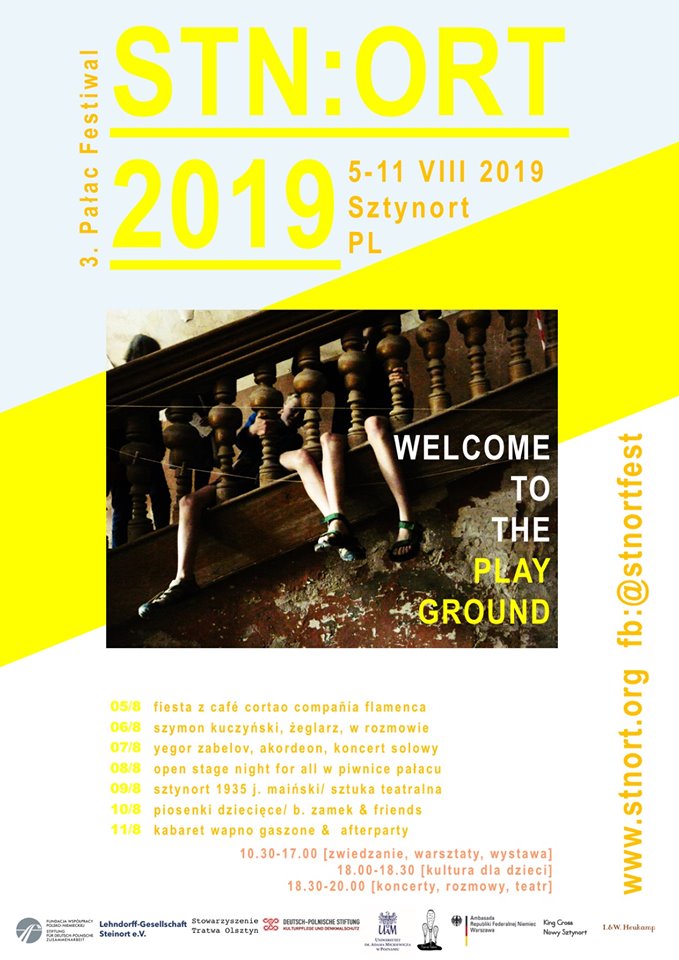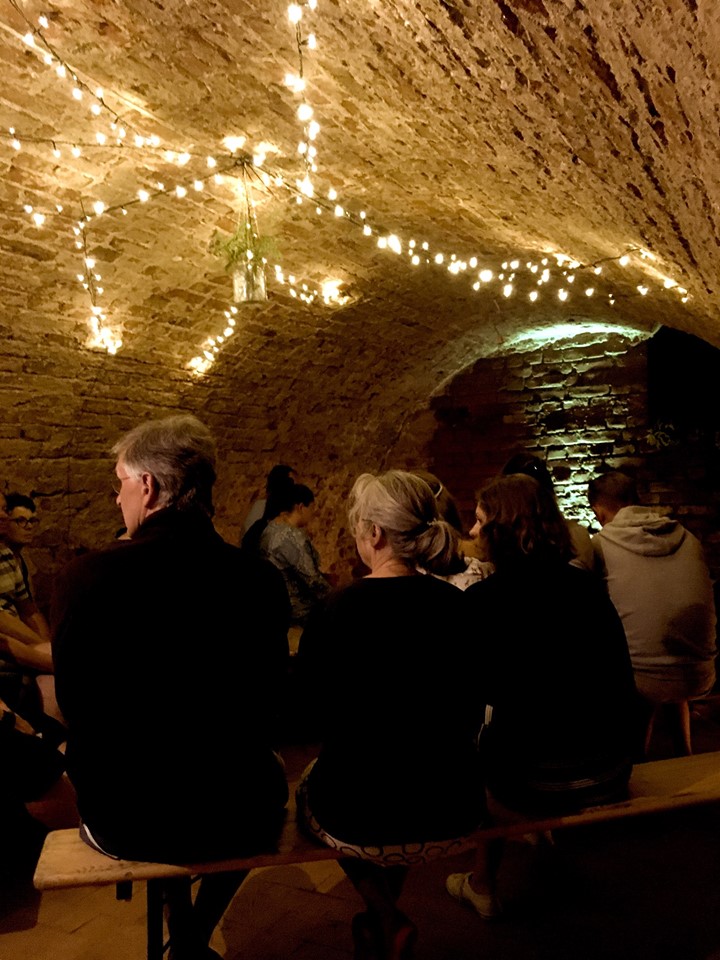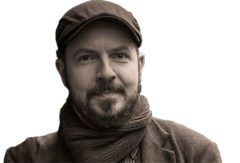
Ich weiß nicht viel über die großen Anwesen in Ostpreußen oder die Familien, die in ihnen lebten. Der Hof meiner Großmutter war ein bürgerlicher, und ich habe von ihr nie etwas über die Adelsfamilien in ihrer Nachbarschaft oder den umliegenden Ländereien gehört. Natürlich habe ich die Geschichten von Marion Gräfin Dönhoff gelesen, über die Dönhoffs und Dohnas und Lehndorffs und die vielen verschwundenen Gutshäuser im ehemaligen Ostpreußen wie Schlobitten und Friedrichstein – und über ihre historische, künstlerische und soziale Bedeutung. Ich freue mich sehr, dass ich Stadtschreiber nächste Woche die Eingeweide eines der verbleibenden Paläste erkunden kann.
In Steinort/Sztynort in der Gemeinde Angerburg/Węgorzewo in Masuren befindet sich der Palast der Familie Lehndorff. Das Schloss war seit dem späten 15. oder frühen 16. Jahrhundert im Besitz der Familie und verblieb hier bis 1945. Es war eines der größten Güter in Ostpreußen mit einer Größe von 5500 Hektar und das herrlich baufällige Schloss, das sich hier heute befindet, wurde von Marie Eleonore von Lehndorff (geb. von Dönhoff) erbaut, nachdem ein älteres Gebäude 1656 von polnischen Tataren zerstört worden war. Im Laufe der Jahrhunderte war es ein Treffpunkt vieler bedeutender Persönlichkeiten wie Ignacy Krasicki oder der Gräfin Dönhoff – aber auch der Nationalsozialisten. Der deutsche Außenminister Joachim von Ribbentrop nutzte das Schloss während seines gesamten Aufenthalts in der nahen Wolfsschanze, dem Hauptquartier von Adolf Hitler zwischen 1941 und 1944.
Der letzte Besitzer des Palastes, Heinrich Graf von Lehndorff, wurde von den Nationalsozialisten wegen seiner Beteiligung an der Verschwörung gegen Hitler am 21. Juli 1944 hier verhaftet. Er war zuerst durch ein Fenster seines Anwesens geflüchtet und hatte sich in den nahe gelegenen Mooren versteckt, sich dann aber gestellt, nachdem seine Frau Gottliebe von den Nazis als Geisel genommen wurde. Auf dem Weg zu seinem Prozess in Berlin entkam er ein zweites Mal, flüchtete 120 Kilometer nach Norden in Richtung des Anwesens eines Freundes der Familie, wurde jedoch wieder gefasst und am 4. September 1944 in Berlin-Plötzensee hingerichtet.
Nach 1945 war der Palast mehrere Jahre von der Roten Armee besetzt und 1950 zog eine landwirtschaftliche Genossenschaft ein. 1990 erwarb ein österreichischer Geschäftsmann das Anwesen, der es anschließend an eine Firma aus Warschau veräußerte, die es dann schließlich an die Gemeinde verkaufte. Für die nächsten Jahrzehnte blieb es vernachlässigt und verfiel zunehmend. Im Jahr 2009 ging der Palast dann auf die Deutsch-Polnische Stiftung Kulturpflege und Denkmalschutz über, und der Wiederaufbau begann im Jahr 2010. Die Bemühungen um den Wiederaufbau und die Erhaltung verlaufen aufgrund fehlender Fördergelder recht langsam, aber eine engagierte Gruppe von Steinort/ Sztynort-Enthusiasten arbeitet daran, den Palast zu erhalten – nicht nur als Gedenkort, sondern als Treffpunkt, von dem die gesamte Gemeinde wie auch Besucher aus aller Welt profitieren können. Es gibt viele Initiativen, die zusammen am Erhalt von Steinort arbeiten, darunter die Lehndorff Gesellschaft Steinort e.V., die Stiftung Deutsch-Polnische Zusammenarbeit/Fundacja Współpracy Polsko-Niemieckiej, die Technische Universität Dresden und viele mehr.
Die Mauern eines Schlosses bestehen nicht allein aus Backsteinen und Mörtel. Sie sind auch aus Netzwerken von Menschen gemacht, aus Geschichten, Erinnerungen, Phantasien und Visionen. Ein Schloss besteht aus Begegnungen und Interaktionen zwischen Materialien und Lebewesen. Es zum Leben erwecken bedeutet, Menschen zusammenzubringen, einander zu erzählen, und sich den Raum gemeinsam mit seiner gebauten und natürlichen Umgebung anzueignen – mit allen Sinnen.
STN:ORT Festival
Teil des Unterstützungsprogramms ist das STN:ORT Festival 2019, das von einer Gruppe von Freiwilligen aus dem In- und Ausland durchgeführt wird. In seinem zweiten offiziellen Jahr ist dies eine spielerische Auseinandersetzung mit dem erstaunlichen Ort und der Geschichte von Steinort/Sztynort. Das Festival findet vom 5. bis 11. August 2019 statt und bietet ein fantastisches Programm mit einem Gespräch mit Weltumsegler Szymon Kuczyński, einem Solokonzert des weißrussischen Komponisten und Akkordeonvirtuosen Yegor Zabelov und dem Debüt des Dramatikers und Regisseurs Jakub Maiński: „Sztynort 1935“ ist eine Theaterproduktion des Festivals, von der es auch eine professionelle 360°-VR-Aufnahme geben wird. Insgesamt wird ein starker Fokus sowohl auf die Beteiligung der Gemeinde als auch auf eine ehrliche, offene Auseinandersetzung mit dem Festivalthema gelegt – und auch auf die negativen Konnotationen, die „Spielplätze“ haben können. Wenn man sie einrichtet und öffnet, kann dort jeder tun und lassen, was er will?
Mein eigener Beitrag dazu ist die Moderation der offenen Bühne zusammen mit Hannah Wadle, Festivalgründerin, Anthropologin, Kulturaktivistin und Künstlerin. Die offene Bühne findet am Donnerstag, dem 8. August 2019, in den Gewölben des Palastes statt. Ich werde hier auch ein paar kurze Texte aus meinem Blog und einige neue Texte lesen, die von Ermland-Masuren inspiriert sind – sowohl in Englisch wie auch Deutsch. Die offene Bühne beginnt um 18.30 Uhr, jeder ist willkommen und genau wie für das ganze Festival ist der Eintritt frei.

STN:ORT
I don’t know much about the grand houses of East Prussia or the families that lived in them. My grandmother’s farm was a bourgeois one, and I never learned anything about the noble families in her neighbourhood or the surrounding lands from her. I have of course read the tales of Marion Graefin Dönhoff, about the Dönhoffs and Dohnas and Lehndorfs, and about the many vanished grand estates in former East Prussia like Schlobitten and Friedrichstein – and about their historical, artistical and social importance. I’m delighted that as writer in residence I will be able to explore the very bowels of one of the remaining great houses next week.
Sztynort/Steinort in Gmina Węgorzewo in Mazury is where the palace of the Lehndorff family is located. The palace was the property of the Lehndorff family since the late 15th or early 16th century and remained family property until 1945. It was one of the largest estates in East Prussia with a whooping 5500 hectares, and the gloriously dilapitated palace that can be found here today was built by Marie Eleonore von Lehndorff (née von Dönhoff) after an older building had been destroyed by Polish Tatars in 1656. Over the centuries many distinguished people mingled – but also the Nazis. German Foreign minister Joachim von Ribbentrop used the palace throughout his stay at the Wolfsschanze headquarter of Adolf Hitler between 1941 and 1944.The last owner of the estate, Heinrich Count von Lehndorff, was arrested by the Nazis for his participation in the plot against Hitler and the assassination attempt on July 21, 1944. He had first escaped through a window of his estate and hid in the moors nearby, only to come out of hiding as his wife Gottliebe had been taken hostage by the Nazis. He escaped a second time on the way to his trial in Berlin, hiked 120 kilometres north towards the estate of a family friend but was subsequently arrested and executed on September 4th, 1944 in Berlin Plötzensee.

After 1945, the palace was occupied for several years by the Red Army, and an agricultural cooperative moved in in 1950. In 1990, it was acquired by an Austrian businessman who subsequently sold it to a company from Warsaw which then sold it to the borough. For the next decades it remained neglected and fell into more disrepair. In 2009, the ownership of the palace was transferred to the German-Polish Foundation for Cultural Maintenance and historic Preservation (Deutsch-Polnische Stiftung Kulturpflege und Denkmalschutz), and reconstruction of the ruins began in 2010. These reconstruction and preservation efforts have been moving quite slow, but a dedicated group of Sztynort/Steinort enthusiasts is working towards preserving the palace, not as a museum celebrating a certain period of the past, but as a living place that the whole community in Poland can profit from, but one that is also open for visitors from around the world. There are many initiatives working towards the preservation of Sztynort/Steinort, among them the Lehndorff Gesellschaft Steinort e.V., the Stiftung Deutsch-Polnische Zusammenarbeit/Fundacja Współpracy Polsko-Niemieckiej, the Technische Universität Dresden and many more.
The walls of a palace are not only made of bricks and mortar. They are also made from the networks of people, from stories, memories, imaginaries, and visions. A palace is made of encounters and interactions between materials and living beings. To bring it to life means to bring people together, tell stories, and to appropriate spaces with its built and natural environment – and with all senses.
STN:ORT Festival
Part of this support programme is the STN:ORT Festival 2019, run by a group of volunteers from Poland and abroad. In its second official year, this is a playful engagement with the amazing place and history that is Sztynort/Steinort. The festival takes place from August 5 to August 11, and has a fantastic programme that includes a talk with round-the-world Sailor Szymon Kuczyński, a solo concert of Belorussian composer and accordion virtuoso Yegor Zabelov and the debut of playwright and director Jakub Maiński ‚Sztynort 1935‘ a theatre production made by the festival itself of which there will also be a professional 360° VR recording. Overall there will be strong focus on both community participation and an honest, open engagement with the festival theme – and also the negative connotations ‚playground(s)‘ may have. When you open it up, will you let anyone run wild?
My own small contribution to this will be hosting the the open stage together with Hannah Wadle, founder of the festival, anthropologist, cultural activist and artist. The open night takes place deep bowels of the palace on Thursday, August 8th, and I’ll also read a few short pieces from the blog and also some new pieces inspired by Warmia-Mazury, both in English and German. The open stage starts at 6.30 pm. All are welcome, and like the whole festival, it is a free event.


